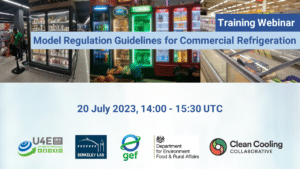Commercial refrigeration equipment, such as refrigerated display cabinets, beverage coolers, ice cream freezers and vending machines, is essential for the storage or display of foodstuffs in the retail and food service sectors. Over 120 million units were estimated to be in operation worldwide in 2010[1]. It is projected that by 2040, the electricity consumption for an ever-growing stock of commercial refrigeration will increase by nearly 40%. Fortunately, technologies are widely available to improve energy efficiency and use refrigerants with a lower global warming potential. For example, outdated commercial refrigeration equipment can consume over 10,000 kilowatt-hours (kWh) of electricity per year, whereas some of the best equipment can consume less than one fifth as much for the same display area or storage volume. Such savings have profound impacts on the financial and environmental costs to own and operate these devices.
Based on UNEP U4E’s Country Savings Assessments, improving the energy-efficiency of this equipment has the potential to achieve annual savings of over 66 TWh of electricity in 2040, thereby avoiding the construction of 30 large power plants, reducing CO2 emissions by more than 64 million tonnes and saving businesses $9.5 billion on their electricity bills.
Minimum Energy Performance Standards (MEPS) and energy labels, if well designed and enforced, are among the fastest and most effective approaches to transition markets toward more energy-efficient products and achieve these potential savings. However, while many countries have MEPS and/or labels for domestic refrigerating appliances, few developing and emerging economies have them for commercial refrigeration equipment. There is little driver to encourage the introduction of energy-efficient and environmentally-friendly products if there is a not a level playing field and opportunity to credibly inform users of the benefits.
Inadequate MEPS and labels leave countries vulnerable to being dumping grounds for products that cannot be sold elsewhere. Because of the large range of product types and technologies used in this sector, development of robust national policies is no easy task.
This is where UNEP U4E’s Model Regulation Guidelines for Energy-Efficient and Climate-Friendly Commercial Refrigeration Equipment come in, offering a foundation for setting energy efficiency, functional performance, and refrigerant requirements and other considerations such as definitions, scope of coverage and test procedures based on international best practices.
Having successfully implemented regulations for residential cooling appliances, the Brazilian government has turned its attention to the commercial sector. A Policy Working Group, comprising public and private sector institutions, has been discussing the technical details required to adapt best international practices to the Brazilian context in order to implement MEPS and energy efficiency labels regulations for commercial refrigerators. In this, the Model Regulation Guidelines provided an invaluable starting point to understand the savings potentials and the technical specifications that are required to achieve these savings. The regulatory process is ongoing, and it is expected that MEPS more ambitious even than the high-efficiency requirements specified in the Model Regulation Guidelines will be implemented at the end of this decade. According to Alexandra Maciel from the Ministry of Mines and Energy, “The new regulations will aim to reduce energy consumption in the commercial sector by over 15% compared to the business-as-usual scenario (10 years after implementation).”
The Guidelines were developed in consultation with a volunteer group of experts from various sectors and regions to balance ambitious recommendations without adverse impacts on the upfront costs and availability of products.
Three levels are presented in the Guidelines – low-efficiency requirements which largely align with the Australian 2021 and European Union MEPS, which went into effect in 2021, and intermediate- and high-efficiency requirements which are 30 per cent and 60 per cent more stringent, respectively, than the lower-efficiency requirements. The latter are helpful in setting labelling tiers and may be suitable for incentive schemes, public procurement programmes and similar interventions to encourage the introduction of high-performance products.
UNEP U4E hosted a webinar on 20 July 2023, with experts from Lawrence Berkeley National Laboratory and representatives from Chile and the Government of Brazil to explain the Model Regulation Guidelines for Energy-Efficient and Climate-Friendly Commercial Refrigeration Equipment and provide insights on the lessons learned in putting them into practice.
Download webinar recording and materials
[1] International Institute of Refrigeration (IIR, 2019). The Role of Refrigeration in the Global Economy. https://iifiir.org/en/fridoc/the-role-of-refrigeration-in-the-global-economy-2019-142028
